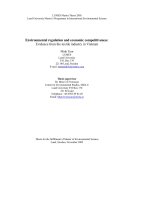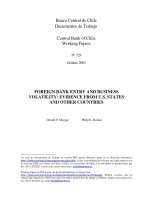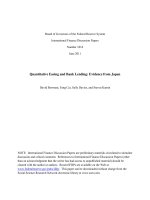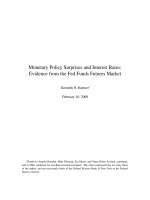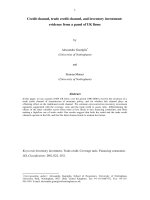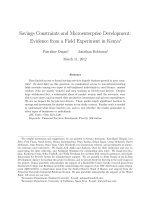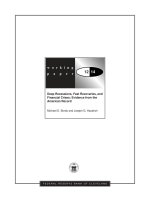Managerial risk taking and secured debt evidence from REITS
Bạn đang xem bản rút gọn của tài liệu. Xem và tải ngay bản đầy đủ của tài liệu tại đây (714.56 KB, 85 trang )
MANAGERIAL RISK-TAKING AND SECURED
DEBT: EVIDENCE FROM REITS
WEI YUAN
(B.M., Renmin Uinversity)
A THESIS SUBMITTED
FOR THE DEGREE OF MASTER OF SCIENCE
DEPARTMENT OF REAL ESTATE
NATIONAL UNIVERSITY OF SINGAPORE
2011
Acknowledgement
First and most, my sincere thanks go to my supervisors: Prof. ONG Seow Eng, for his
inspiring guidance, valuable comments and continuous encouragement throughout the
whole process of my study.
My gratitude is also extended to all the staffs in the Department of Real Estate,
National University of Singapore, both academic and administrative, especially Head
of Real Estate Department Yu Shi Ming, Assistant Professor Tu Yong, and Assistant
Professor Fu Yuming, who provide great support and trust in the past few years.
Thanks to National University of Singapore for offering me the precious opportunity
to pursue a master degree in real estate and urban economics.
In addition, I would like to express my gratitude to my friends, especially Lin
Guangming, Tang Yuhui, Zhao Daxuan, Qiu Leiju, Zhang Huiming, Peng Siyuan, Liu
Jingran, Shen Yinjie, Jiang Yuxi, Chen Wei, Liang Lanfeng, Feng Yinbin, Deng
Xiaoying, for their continuous assistance and companionship during my study.
Most importantly, I would like to thank my mother, Chen Weiping for her
understanding in the past few years. I greatly appreciate my husband Wang Jian for
his selfless love and consistent support in my life.
i
Table of Contents
Acknowledgement .......................................................................................................... i
Table of Contents .......................................................................................................... iv
List of Tables and Figures ............................................................................................. vi
Summary ......................................................................................................................vii
Chapter 1 Introduction ............................................................................. 1
1.1 Motivations ...................................................................................................... 1
1.2 Research Questions .......................................................................................... 5
1.3 Objectives ........................................................................................................ 6
1.4 Significance...................................................................................................... 6
1.5 Organization ..................................................................................................... 9
Chapter 2 Literature Review .................................................................. 11
2.1 Introduction .................................................................................................... 11
2.2 Literature on Managerial Risk Incentive and Corporate Policy Making ....... 11
2.2.1 Literature on Managerial Risk Incentive Estimation .......................... 11
2.2.2 Literature on Managerial Risk Incentive and Corporate Debt Policy . 14
2.2.3 Literature on the Impact of Managerial Risk Incentive on Financial
Decisions in the context of REITs................................................................ 20
2.3 Literature on Secured Debt ............................................................................ 21
2.3.1 Literature on Secured Debt in Corporate Finance .............................. 21
2.3.2 Literature on Secured Debt in context of REITs ................................. 28
2.4 Hypotheses ..................................................................................................... 29
2.5 Summary ........................................................................................................ 32
Chapter 3 Data and Descriptive Statistics ............................................... 36
3.1 Introduction .................................................................................................... 36
iv
3.2 Data sources and Sample Selection ............................................................... 36
3.3 Variable Descriptions ..................................................................................... 37
3.4 Sample Distribution and Summary Statistics................................................. 44
3.5 Summary ........................................................................................................ 51
Chapter 4 Empirical Methods and Results ............................................. 52
4.1 Introduction .................................................................................................... 52
4.2 Secured Debt Ratio and CEO Managerial Risk-taking Incentives ................ 52
4.2.1 Random Effect Analysis ...................................................................... 52
4.2.2 Two Stage Least Square (2SLS) Estimation ....................................... 56
4.2.3 Change-in-Variables Analysis ............................................................. 59
4.3 Wealth effect of Secured Debt and CEO Managerial Risk-taking Incentives 61
4.4 Summary ........................................................................................................ 65
Chapter 5 Conclusions ........................................................................... 67
5.1 Contributions.................................................................................................. 67
5.2 Summary of Main Findings ........................................................................... 68
5.3 Limitations ..................................................................................................... 69
5.4 Recommendation for Further Research ......................................................... 71
Bibliography ................................................................................................................ 73
Appendix A .................................................................................................................. 78
v
List of Tables and Figures
Table 3.1
Definitions of the Characters in modified B-S model …….……38
Table 3.2
Sample Distribution …………………………………………….44
Table 3.3A
Summary Statistics…………………………………………….. 45
Table 3.3B
Descriptive Statistics of DELTA and VEGA Decomposition…...46
Table 3.4
Correlation between Secured debt ratio, LNDELAT, LNVEGA
and Firm Characteristics…….………………………………......46
Table 4.1
Relation between Secured Debt Ratio and CEO Portfolio Price
/Volatility Sensitivities…………………………………………..55
Table 4.2A
Relation between Secured Debt Ratio and CEO portfolio
Price/Volatility Sensitivities: First Stage Regression of
2SLS…………………………………………………………….57
Table 4.2B
Relation between Secured Debt Ratio and CEO portfolio
Price/Volatility Sensitivities: Second Stage Regression of
2SLS…………………………………………………………….57
Table 4.3
Relation between Secured debt ratio and CEO portfolio
price/Volatility sensitivities: Change in Variable Regressions…..59
Table 4.4
Wealth Effect of the Interaction between CEO Portfolio
Price/Volatility Sensitivities and Secured Debt Ratio Change ....62
Table 4.5
Wealth effect of the interaction between CEO portfolio
price/volatility sensitivities and secured debt ratio change:
Robustness test………………………………………………….64
Figure 3.1
Scatter Plot of Within Firm Secured Debt Ratio and Secured Debt
Ratio Volatility…………………………………………………..48
Figure 3.2
Scatter Plot of Within Firm LNDELTA Mean and Standard
Deviation………………………………………………………...49
Figure 3.3
Scatter Plot of Within Firm LNVEGA Mean and Standard
Deviation………………………………………………………...49
vi
Summary
This study focuses on the correlation between secured debt and managerial risk-taking
incentive. A few findings need to be emphasized. First is the positive relation between
secured debt and managerial risk-taking incentive (LNVEGA). This relation is
confirmed by several robustness tests. This relation indicates that secured debt ratio is
affected by executive compensation and increases in managerial risk-taking incentive.
Second, I posit that this positive relation can be explained in two possible ways. “Free
cash flow hypothesis” gives the reason that firms with high risk-taking incentives
would like to use more secured debt to generate extra cash to finance risky projects.
On the other hand, “Cost contracting hypothesis” implies that the positive relation is
driven by the fact that shareholders try to raise secured debt ratio to compensate
creditors due to the increasing managerial risk-taking incentives. These two
hypotheses have different predictions for the wealth effect of secured debt ratio
change. That is how I distinguish them to find out what drives the positive relation
between secured debt ratio and managerial risk-taking incentive.
Overall, this research extends literature in several ways, including executive
equity-based compensation, determinants of secured debt issuance and agency cost of
debt. Among them, the key finding of this study lies in the role of secured debt in
mitigating the agency cost between shareholders and creditors arising from
managerial risk-taking incentive.
vii
Chapter 1 Introduction
1.1 Motivations
The use of equity-based executive compensation, such as stock and option, has widely
increased over the past few decades (Murphy, 1999). The effects of managerial
compensation incentives on financing and investment policies have been evaluated in
two different aspects. One is the managerial option portfolio sensitivity to stock price,
which aligns the interest of risk-averse and undiversified manager with the interests of
shareholders. This is considered as managerial risk-decreasing incentive. The other is
managerial option portfolio sensitivity to stock return volatility, which encourages
managers to take riskier investment and financing policies (Core & Guay, 2002). It is
viewed as managerial risk-taking incentive. There is a growing body of literature
focusing on how managerial compensation incentives could affect corporate policies,
such as corporate capital structure, debt maturity, and corporate liquidity policy
(Cohen et al., 2000; Coles et al., 2006; Brockman et al., 2010). To my knowledge,
very few studies have examined how managerial risk-taking incentive affects secured
debt.
The significance of secured debt lies in the fairly large amount of secured debt, which
takes a big proportion of firms’ total liabilities. Berger & Udell (1990) and Harhoff &
1
Korting (1998) found that nearly 70% of commercial and industrial loans are secured
in the US and UK. In addition, the World Bank Investment Climate Survey1 indicates
that real estate represents 50% of collateral for firms in 58 emerging countries, which
suggests real estate is considered as one of the most important forms of collateral. All
these studies point out the importance of secured debt.
When looking through the literature, I found that secured debt as part of corporate
debt policy could be affected by managerial risk-taking incentive. Moreover, theories
have different predictions towards the correlation between secured debt and
managerial risk-taking incentive.
Jensen & Mecking (1976) have found that equity-based compensation, especially
stock options, could motivate managers to adopt risky corporate policies. Coles et al.
(2006) argue that managerial risk-taking incentive arising from equity compensation
provides a CEO with an incentive to invest in riskier assets and obtain more
aggressive debt policies with more flexibility and higher cost. Therefore, managerial
risk-taking incentive would be inversely related to secured debt ratio (the portion of
secured debt in total liabilities).
On the other hand, the literature also suggests a positive relation between managerial
risk-taking incentive and secured debt ratio. First, Berkovitch & Kim (1990)
1
See for further details.
2
documents that debt with pledged assets could induce overinvestment problems due to
the lower cost of secured debt. Firms with managerial risk-taking incentives could use
more secured debt to generate extra cash flow for risky projects. Thus, shareholders
benefit from the risky investment with lower cost of debt, and firms with high
managerial option portfolio sensitivities to stock return volatilities would prefer to use
more secured debt.
Second, Brockman et al. (2010) and Billett et al. (2010) argue that firms with higher
managerial risk-taking incentives are more likely to engage in asset substitution
problem and exacerbate the interest conflicts between shareholders and creditors. The
rationale is that managers with risk-taking incentives may jeopardize creditors’
benefits by substituting less risky assets for risky ones. Creditors will require
protection and cost of debt will increase. As a result, firms with managerial
risk-taking incentives probably have to compensate creditors through certain
corporate policies, such as shorter debt maturity. As suggested by Barclay & Smith
(1995) asset substitution problem could be alleviated by raising the amount of secured
debt in the total liabilities. Thus, higher secured debt ratio could be an alternative
other than more short-term debt for firms with managerial risk-taking incentives to
reduce shareholder-creditor agency conflict, which means a positive relation between
risk-taking incentive and secured debt ratio.
Taken together, these different theoretical predictions and perspectives on how
managerial risk-taking incentive affects secured debt ratio suggest that secured debt
3
can be an interesting and valuable topic on how managerial incentives influence
shareholders, creditors and their relations. In this thesis, I examine how managerial
risk-taking incentive affects secured debt and try to find out the reason behind the
effect of managerial risk-taking on secured debt.
Although to examine the impact of managerial risk-taking incentive on secured debt
could yield intriguing results, very few studies focus on this topic. The first reason,
from my point of view, is the recent advanced methodology in evaluating managerial
risk incentives through equity compensation. Core & Guay (2002) argue that a better
approach to evaluate managerial risk incentives is to examine how the value of
managerial option holdings will increase or decrease due to 1% change in stock price
and stock return volatility. This approach provides a brand new angle to estimate
managerial equity compensation, rather than the number of options, or the granted
value of options. This approach has been widely used since 2002 (See Coles et al.,
2006; Shaw, 2007; Low, 2009; Brockman et al., 2010; Liu et al.2010, among others.).
Secondly, the usage of secured debt and its function in capital structure are still a
growing and less developed research area in literature. Smith (1985) documents the
usage of secured debt could assist firms in achieving the optimal capital structure.
Ambrose et al. (2010) examine market reaction to the issue of secured debt in REIT
industry. However, very few studies link managerial risk incentive with secured debt.
In addition, availability of collaterals limits the usage of secured debt. Most of the
studies regarding corporate policies or managerial risk incentive consider all the
4
industries in their empirical designs, whereas most of the industries do not possess
large amount of assets that could be used as collaterals, which restricts their ability to
issue secured debt, or to consider secured debt as agency-cost reducing approach.
Thus, I use REIT sample to test the impact of managerial risk-taking on secured debt.
REIT industry could provide a better test bed to examine the impact of managerial
risk-taking on secured debt partly because REITs possess quite a few properties as
their assets which are easy to collateralize, so REITs may have more flexibility on
secured debt usage and their debt security policies could play a better role in revealing
managerial incentives and controlling agency problem. On the other hand, REIT
industry with its special structure and tax-exempt status has been used to test various
capital structure theories. To examine the usage of secured debt in REITs, as a
different perspective to look into capital structure, may provide new insight to capital
structure literature. In addition, REIT managerial risk-taking incentive seems higher
than those of other sectors when REIT managerial risk-taking incentive computed
through equity compensation is compared with those of other industrial firms
documented in Coles et al. (2006), Brockman et al.(2010), Chava & Purnanandam
(2010), and others. This feature migh make REITs as an interesting sample to examine
the relation betwwen managerial risk-taking incentive and secured debt.
1.2 Research Questions
Given all these motivations, this research is designed to address the following
research questions:
5
1. What is the impact of managerial risk-taking incentive on secured debt in
REIT industry?
2. If managerial risk-taking incentive does influence secured debt, what are the
possible reasons and explanations for the relation between managerial
risk-taking incentive and secured debt utilization?
1.3 Objectives
In comparison with prevailing research with respect to managerial risk incentive and
secured debt, this work will examine the impact of managerial risk-taking incentive
on secured debt ratio, particularly in REIT industry.
First, it examines how the compensation risk-taking incentive affects the reliance of
firms on secured debt in the specific REITs market.
Second, it explores the dominant explanation for this significant relation between
secured debt ratio and managerial risk-taking incentive by examining the possible
relationship between REITs excess return and secured debt ratio change associated
with managerial risk-taking incentive.
1.4 Significance
To my knowledge, very few studies have examined the influence of CEO risk-taking
incentive on secured debt ratio. There are a large number of studies looking into
managerial incentives and corporate financial policies, such as capital structure, debt
6
maturity, etc (Coles et al.2006; Brockman et al.2010). However, secured debt has not
been taken into consideration. Also, when these studies link the managerial incentives
with corporate policies, they mainly concern agency conflict between managers and
shareholders, whereas they overlook agency cost between shareholders and creditors.
This is one of the first attempts to detect the effects of CEO risk-taking incentive on
corporate debt security decision in REITs. REIT industry is constructed as a
regulatory industry. However, agency problems in REIT industry is still severe and
likely to be missed. Recently a few studies have looked into REITs corporate
governance such as board structure and institutional holding (Ghosh et al. 2010; Feng
et al.2010), and compensation structure (Pennathur et al. 2005). All of these studies
focus on how to align managerial incentives with shareholders’ interests and how
managerial incentive would affect firm value. However, interest conflict between
shareholders and creditors due to managerial risk-taking incentive has not been
carefully considered.
This study makes a few contributions to the existing literature. First, the main finding
of this work is that secured debt could alleviate asset substitution problem between
shareholders and creditors arising from managerial risk-taking incentive. This finding
provides empirical support for two theories. On the one hand, it supports Jensen &
Meckling’s (1976) argument that managerial incentive through equity-based
compensation could exacerbate the interest conflicts between shareholders and
creditors. On the other hand, Barclay & Smith (1995) assert that debt maturity and
7
secured debt could mitigate asset substitution problem between shareholders and
creditors. Related work by Brockman et al. (2010) find that debt maturity could
attenuate agency cost associated with asset substitution for high CEO risk-taking
preference. My finding exhibits the evidence that secured debt could also resolve the
interest conflicts between shareholders and creditors arising from managerial
risk-taking incentives.
The empirical findings also add to the literature on corporate secured debt. Leeth &
Scott (1989) and Barclay & Smith (1995) find that secured debt is affected by firm
characteristics such as firm size, debt maturity, growth opportunity. Ooi (2001)
provides evidence that managerial ownership would affect secured debt usage. This
work extends the literature by pointing out that CEO compensation incentive is an
additional determinant of corporate secured debt utilization.
Further, this study expands the understanding of managerial risk-taking incentive on
corporate capital structure. Novaes & Zingales (1995) indicate that entrenched
managers would have different optimal leverage choices compared with shareholders.
Cohen et al. (2000) and Coles et al. (2006) document firms with higher risk-taking
incentives implement high leverages. Brockman et al. (2010) suggest risk-taking
incentives would reduce debt maturity. Hart & Moore (1993) argue that self-interested
managers would prefer lower amount of senior (secured) debt that will limit their
ability to raise new funds. The study exhibits new evidence that managerial
risk-taking incentive would increase secured debt ratio.
8
The work also sheds light on creditors’ evaluation of the impact of managerial
risk-taking incentive on secured debt. As suggested by Brockman et al. (2010) and
Brillet et al. (2010), creditors will fully consider the risk-shifting and asset
substitution problems arising from managerial incentive, rationally evaluate them, and
request compensation because of them.
In term of methodology, this study examines wealth effect of secured debt ratio
change to find out how agency cost changes along with CEO risk-taking incentive. I
follow the approach used by Faulkender & Wang (2006) and Lin et al. (2010), to
compute excess return as dependent variable, and interaction between secured debt
ratio change and CEO risk-taking incentive as independent variable. One significant
feature of this study is to construct the unique REITs benchmark portfolio in order to
compute the excess return when previous studies use the existing databases.
1.5 Organization
This dissertation is organized into five chapters.
Chapter 1 presents a general introduction to motivations, research questions,
objectives, significance and organization of this dissertation.
Chapter 2 provides a literature review of related studied and develops the hypotheses
based on the review.
Chapter 3 illustrates the data source, sample selection and descriptive statistics.
9
Chapter 4 exhibits the empirical methods and results
Chapter 5 summarizes the main findings and also covers the research limitations and
recommendations for future research.
10
Chapter 2 Literature Review
2.1 Introduction
The literature on managerial compensation has been considered as a significant
research field since the 1980s. However, managerial risk incentive through equity
compensation is rather an undeveloped area until Core & Guay (2002) created the
proper proxies to evaluate how equity compensation aligns managerial incentives and
affect managerial risk attitudes. On the other hand, although secured debt has been
widely studied as one of the crucial debt financing options, the linkage between
secured debt and managerial risk incentives has rarely been explored. In order to
discover this connection and find out the possible reason behind this connection, this
chapter will begin with a comprehensive review of managerial incentive and secured
debt followed by theoretical predictions on the connection between managerial
risk-taking incentive and secured debt. Finally this chapter ends with the summary of
all these studies, research gap and hypotheses.
2.2 Literature on Managerial Risk Incentive and Corporate Policy Making
2.2.1 Literature on Managerial Risk Incentive Estimation
A. Relatively Rough Estimation of Managerial Risk Incentive in 1990s
Managerial risk appetite influences corporate financial decision in an essential way
over well known firm specific factors. Stock option is widely used in the managerial
11
compensation structure as an incentive to mitigate agency cost between managers and
shareholders. Option value has sharply increased as part of managerial compensation
in the past few years and firms are inclined to enhance the alignment between
managerial risk incentive and firm performance.
A growing body of literature focuses on the analysis of the effect of managerial
incentive on corporate financial policies. Agrawal & Gershon (1987) find that firms
with high stock and option ownership would engage in more variance-increasing
acquisitions. DeFusco et al. (1990) argue that firms with granted stock option plan
from 1978 to 1982 induced the increase in stock return variance. Lambert et.al (1991)
argue that measuring the sensitivity of the managerial compensation change with
respect to corporate performance variable change is preferred to assess managerial
incentives.
Mehran (1995), Tufano (1996), Berger et al. (1997), Schrand & Unal (1998) explore
the link between managerial equity-based compensation and financial strategies such
as leverage, stock repurchase, or the derivatives usage and hedging, but give different
conclusions. Denis et al. (1997) examine the association between managerial stock
holdings and corporate focus. So far, the literature related to managerial equity-based
compensation before 2002 mainly use a relatively rudimentary proxy of option
compensation as the explanatory variables such as scaled, unscaled, or transformed
measures of value or number of option granted, stock vested or held, etc. These
measures missed certain important characteristics which could be represented by later
12
advanced proxies (vega and delta) created by Core & Guay (2002).
B. Managerial Option Portfolio Sensitivities Estimation by Core & Guay (2002)
To estimate managerial risk incentives, Core & Guay (2002) computes two proxies,
delta and vega, based on the stock and option holdings of executives. Delta, measures
the sensitivity of executive option portfolio to firm stock price. That is how the value
of managerial stock and option holdings could change with respect to 1% percent
change in firm stock price. High delta suggests that managers are motivated by
shareholders to make efforts to increase shareholders’ wealth. Compared with
diversified outside shareholders, disproportionately large fraction of undiversified
managers’ wealth is offered by firm, and the value of their human capital is tied with
corporate performance (Fama, 1980; Smith & Stulz, 1985). Therefore, managers with
high delta would probably prefer to take less risk when they make financial decisions.
Delta is considered as a proxy of managerial risk-decreasing incentive.
Vega measures how the value of managerial equity compensation changes with
respect to 1% change in stock return volatility. It means that managers will benefit
from risk-increasing policies since these policies induce stock return volatility.
Therefore, vega is viewed as a managerial risk-increasing incentive.
Gore & Guay (2002) suggests that sensitivity of executive option portfolio to stock
return volatility is positively correlated with firm growth opportunities. Rajgopal &
Shevlin (2002) find that the increased sensitivity of executive option portfolio to stock
13
return volatility could induce more risk-taking corporate policies and less risk
aversion using a sample of firms in oil and gas industry. Rajgopal et al. (2004)
indicate that greater sensitivity of managerial option compensation to stock volatility
could lead to higher one year ahead stock return volatility. Coles et.al (2006) analyze
the endogenous problem between executive stock option based compensation. They
conclude that the sensitivity of CEO option compensation to stock volatility is highly
correlated with leverage, R&D expenses and capital expenditures. Further, Knopf et al.
(2002) propose that sensitivity of managerial option compensation to stock price gives
manager incentive to take less risk. They find that managers with higher sensitivities
of managerial option compensation to stock price tend to hedge more risk by using
more derivatives. In addition, Chava & Purnanandam (2010) compare CEOs and
CFOs in terms of their different influences of compensation incentives on corporate
polices. They find that CEOs’ risk preferences through compensation structure are
more likely to affect leverage ratio and cash holdings whereas debt maturity and
accrual management are closely correlated with CFOs’ compensation incentives.
All the reviewed literature indicates that sensitivities of executive option
compensation have significant impact on corporate decision making.
2.2.2 Literature on Managerial Risk Incentive and Corporate Debt Policy
A. Risk Financing Theory in terms of Managerial Risk-taking Incentive and
Corporate Debt Policy
Recent studies have attempted to explore the link between managerial risk-taking
14
incentive and corporate debt financing. They found that risk financing theory provides
an explanation for the connection between managerial risk-taking incentive and debt
financing policies. Risk financing theory suggests that managerial risk-taking
incentive could assist firms in adopting risky corporate debt policies.
Cohen et al. (2000) conclude that leverage is positively correlated with CEO option
portfolio sensitivity to stock return volatility. Coles et.al (2006) posit the positive
relation between managerial incentives through vega and leverage. They consider that
managerial incentives and financial policies are jointly determined. For the
endogeneity concern, they apply several econometric approaches to isolate the
influence of vega on financial policies. They point out that the leverage is an essential
way for firms to increase risk. Therefore firms with large managerial risk-increasing
incentive would prefer high leverage. Their findings are consistent with risk financing
theory. Firms with high vegas would favor high risk debt policies.
Chava & Purnanandam (2007) explore the effect of managerial incentives along with
market timing and firm characteristics on floating-fixed rate debt structure. They find
managerial incentives have a strong influence on firm risk shift, which could induce
firms to obtain variance-increasing debt structure. In addition, Chava & Purnanandam
(2010) undertake an extensive study of the effect of managerial incentives on
corporate policies. They find CEO risk-increasing incentive is correlated with higher
leverage. They interpret this finding to suggest that CEOs intend to adopt higher
leverage when they have risk-increasing preferences. In addition, they also find that
15
CFO risk-taking appetite is associated with shorter debt maturity. They explain that
firms with shorter debt maturity face higher bankruptcy probability compared with
firms with relatively longer debt maturity. In an extreme case, a firm with excessive
shorter maturity debt probably is exposed to considerable refinancing risk as well as
interest rate risk, which could induce large earning volatility. Therefore, shorter
maturity would be the result of risk-taking incentive.
All these studies indicate managerial incentives arising from equity-based
compensation could affect firm debt financing policies. Firms with large managerial
risk-taking incentive (vega) are more inclined to engage in risky debt policies, such as
higher leverage, shorter maturity and higher floating debt ratio to maximize the firm
value as well as the wealth of managers.
To my knowledge, no study has explored the link between managerial risk-taking
incentive and secured debt. If I follow the risk financing theory, the negative relation
between secure debt and managerial risk-taking incentive should be expected since
more secure debt will limit the firm’s ability to make risky financial and investment
policies due to collateral burden. As argued by Jensen & Mecking (1976), and Coles
et al. (2006) firms with risky managers would prefer aggressive corporate policies
with more flexibility, so firms with higher managerial risk-taking incentives would
use less secured debt.
To sum up, risk financing theory predicts that the possibility to adopt risky financing
policies increases in managerial risk-taking incentive. Above studies document that
16
CEO equity-based compensation facilitates firms to align CEOs’ interests with
shareholders’. Therefore, CEOs with larger risk-increasing incentives (vega) intend to
make risky financial decisions. Furthermore, capital structure and debt structure as the
most important financial decisions probably reflect these risk-increasing incentives by
adopting higher leverage ratio, shorter maturity or higher floating-to fixed debt ratio.
As for secured debt, following the risk financing theory, firms with higher managerial
risk-taking incentives would use less secured debt for the great amount of collaterals.
B. Cost Contracting Theory in terms of Managerial Risk Incentives and Debt Policies
Cost contracting theory suggests that if managerial risk-taking incentives could align
managers’ interests with shareholders’, firms have more intention to engage in asset
substitution to shift risk from firms to creditors, therefore agency costs between
shareholders and creditors would be intensified, which could be revealed through cost
of debt. To alleviate the agency cost, firms could use debt policies, such as more
secured debt, shorter debt maturity, etc. The cost contracting theory predicts a positive
relation between managerial risk-taking incentive and agency-cost reducing debt
policies.
Billett et al. (2006) examine stock and bond price reactions when CEOs are granted
equity compensation for the first time. They find significant negative bond price
reactions and large positive stock price reactions. Furthermore, to connect bond price
reaction with managerial incentives, they find that bond price reaction decreases in
CEO option portfolio sensitivity to stock volatility (vega) and stock price reaction
17
increase in risk-increasing vega when CEOs have little or no equity compensation
prior to the grant. They suggest that, equity-based compensation probably aggravates
shareholders-bondholders conflicts when it aligns managers’ interests with
shareholders’.
Shaw (2007) tries to examine the link between managerial incentives and cost of debt.
The author uses various approaches to address the potential agency problem between
shareholders and bondholders by evaluating the bond yields increase or decrease in
managerial risk attitudes associated with equity-based compensation. The author finds
that the cost of debt increases in risk-taking incentive.
Brockman et.al (2010) find the positive (negative) relation between managerial risk
incentive vega (delta) and short-maturity debt. They argue that firms with higher vega
would bear more shareholders-creditors agency cost because managerial risk-taking
incentive (vega) would align managerial incentive with shareholders’ interests on one
side and enlarge agency cost between shareholders and bondholders on the other side.
Therefore firms will obtain more short-maturity debt as a larger proportion of total
debt to mitigate the agency cost when managerial risk-taking incentive (vega) is
relatively high. They also find short-maturity debt could attenuate the impact of vega
on bond yields.
As explained in the cost contracting theory, intensified shareholders-creditors agency
problem arising from managerial risk increasing incentive will be revealed and firms
could adopt agency-cost reducing debt policies to mitigate this problem. The papers
18
above exhibit the evidences that CEO risk-taking incentive distorts creditors’ wealth
in order to enhance shareholders’ benefits and firm value. Therefore, creditors react
negatively to CEO risk-taking incentive (vega), and also the cost of debt measured in
bond yield rises along with vega. In addition, firms with higher CEO vegas could
adjust their debt structure, for example, adopting shorter debt maturity, as a solution to
the exacerbated agency conflicts between shareholders and bondholders. These papers
did not pay attention to secured debt that could serve as effective and efficient debt
policy to decrease shareholders-creditors agency cost due to managerial risk-taking
incentives.
In conclusion, the influence of managerial risk-taking incentive through equity-based
compensation on debt financing policies probably has two aspects. One is, as
suggested by risk financing theory, that firms will adopt risky debt policies, such as
higher leverage ratio, shorter maturity and lower secured debt ratio to align manager’s
interest with shareholders’ risk-taking desire. The other is, as explained by the cost
contracting theory, that firms could use certain debt policies, such as more secured
debt, to mitigate agency cost when managerial risk-taking incentive puts a load on the
relation between shareholders and bondholders, which suggests a positive impact of
managerial risk-taking incentive on secured debt.
All these studies consider the influence of managerial incentives on leverage, debt
maturity, debt floating-to-fixed structure, whereas overlooking the connection
between managerial incentives and secured debt ratio. In my work, I focus on the
19
